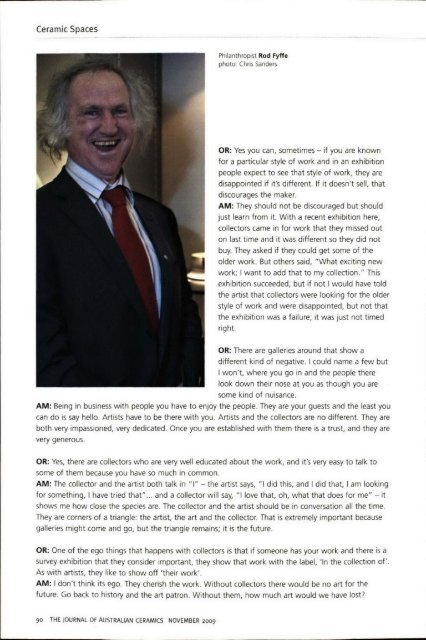The Journal of Australian Ceramics Vol 48 No 3 November 2009
You also want an ePaper? Increase the reach of your titles
YUMPU automatically turns print PDFs into web optimized ePapers that Google loves.
Ceramic Spaces<br />
Philanthropist Rod f yffe<br />
photo; Chris Sanders<br />
OR: Yes you can, sometimes - if you are known<br />
for a particular style <strong>of</strong> work and in an exhibition<br />
people expect to see that style <strong>of</strong> work, they are<br />
disappointed if it's different. If it doesn't sell, that<br />
discourages the maker.<br />
AM: <strong>The</strong>y should not be discouraged but should<br />
just learn from it. With a recent exhibition here,<br />
collectors came in for work that they missed out<br />
on last time and it was different 50 they did not<br />
buy. <strong>The</strong>y asked if they could get some <strong>of</strong> the<br />
older work. But others said, "What exciting new<br />
work; I want to add that to my collection." This<br />
exhibition succeeded, but if not I would have told<br />
the artist that collectors were looking for the older<br />
style <strong>of</strong> work and were disappointed, but not that<br />
the exhibition was a failure; it was just not timed<br />
right.<br />
OR: <strong>The</strong>re are galleries around that show a<br />
different kind <strong>of</strong> negative. I could name a few but<br />
I won't, where you go in and the people there<br />
look down their nose at you as though you are<br />
some kind <strong>of</strong> nuisance.<br />
AM: Being in business with people you have to enjoy the people. <strong>The</strong>y are your guests and the least you<br />
can do is say hello. Artists have to be there with you . Artists and the collectors are no different. <strong>The</strong>y are<br />
both very impassioned, very dedicated. Once you are established with them there is a trust, and they are<br />
very generous.<br />
OR: Yes, there are collectors who are very well educated about the work, and it's very easy to talk to<br />
some <strong>of</strong> them because you have so much in common.<br />
AM: <strong>The</strong> collector and the artist both talk in "I" - the artist says, "I did this, and I did that, I am looking<br />
for something, I have tried that" .. . and a collector will say, "I love that, oh, what that does for me" - it<br />
shows me how close the species are. <strong>The</strong> collector and the artist should be in conversation all the time.<br />
<strong>The</strong>y are corners <strong>of</strong> a triangle: the artist, the art and the collector. That is extremely important because<br />
galleries might come and go, but the triangle remains; it is the future.<br />
OR: One <strong>of</strong> the ego things that happens with collectors is that if someone has your work and there is a<br />
survey exhibition that they consider important, they show that work with the label, 'In the collection <strong>of</strong>'.<br />
As with artists, they like to show <strong>of</strong>f 'their work'.<br />
AM: I don't think its ego. <strong>The</strong>y cherish the work. Without collectors there would be no art for the<br />
future. Go back to history and the art patron. Without them, how much art would we have lost?<br />
90 THE JOURNAL OF AUSTRALIAN CERAMICS NOVEMBER <strong>2009</strong>


















